The laboratory precision oven market expands from USD 63.5 million in 2025 to USD 99.5 million by 2035, creating meaningful opportunities for equipment manufacturers, laboratory supply providers, and automation system integrators. One key opportunity lies in the modernization of analytical and microbiology laboratories, where standardized thermal processing protocols are increasingly required to ensure repeatability and data integrity. Facilities handling pharmaceutical development, component sterilization, and sample conditioning are prioritizing ovens with fine-resolution temperature control, uniform airflow distribution, and validated calibration frameworks. Manufacturers able to offer traceable temperature mapping, IQ/OQ/PQ documentation support, and integration with LIMS platforms will gain a competitive advantage in regulated environments such as clinical diagnostic labs and pharmaceutical QC departments. Floor-standing systems also benefit from replacement demand in university research centers and industrial testing facilities aligning with global GLP/GMP audit expectations.
A second opportunity emerges from the shift toward energy-efficient heating and long-duration thermal stability, where research institutions aim to reduce operational power loads and minimize thermal drift during extended testing cycles. Precision ovens leveraging ceramic fiber insulation, multi-zone heating elements, and adaptive digital PID controllers can reduce cycle variability while improving energy performance metrics. Additionally, manufacturers offering remote monitoring, predictive maintenance diagnostics, and modular chamber capacity configurations stand to capture laboratory segments moving toward automated workflow environments. As global R&D investment increases across biotechnology, materials science, and environmental testing, demand for scalable, repeatable, and tightly controlled heating platforms is expected to expand steadily.

The latter half (2030-2035) will witness steady growth from USD 79.5 million to USD 99.5 million, representing an addition of USD 20.0 million or 56% of the decade's expansion. This period will be defined by mass market penetration of specialized precision oven designs, integration with comprehensive laboratory management platforms, and seamless compatibility with existing scientific equipment infrastructure. The market trajectory signals fundamental shifts in how laboratories approach thermal processing optimization and quality control management, with participants positioned to benefit from steady demand across multiple configuration types and end-use application segments.
The market demonstrates distinct growth phases with varying market characteristics and competitive dynamics. Between 2025 and 2030, the market progresses through its technology adoption phase, expanding from USD 63.5 million to USD 79.5 million with steady annual increments averaging 4.6% growth. This period showcases the transition from basic heating equipment to advanced floor-standing systems with enhanced temperature uniformity capabilities and integrated digital control systems becoming mainstream features.
The 2025-2030 phase adds USD 16.0 million to market value, representing 44% of total decade expansion. Market maturation factors include standardization of laboratory heating protocols and scientific equipment standards, declining component costs for specialized temperature control systems, and increasing industry awareness of precision heating benefits reaching 98-99% temperature accuracy in medical and research applications. Competitive landscape evolution during this period features established equipment manufacturers like Thermo Fisher Scientific and Tempo Instruments expanding their precision oven portfolios while specialty manufacturers focus on advanced control development and enhanced energy efficiency capabilities.
From 2030 to 2035, market dynamics shift toward advanced automation integration and global laboratory expansion, with growth continuing from USD 79.5 million to USD 99.5 million, adding USD 20.0 million or 56% of total expansion. This phase transition centers on specialized temperature control systems, integration with automated laboratory networks, and deployment across diverse medical and research scenarios, becoming standard rather than specialized applications. The competitive environment matures with focus shifting from basic heating capability to comprehensive laboratory workflow optimization systems and integration with data management platforms.
| Metric | Value |
|---|---|
| Market Value (2025) | USD 63.5 million |
| Market Forecast (2035) | USD 99.5 million |
| Growth Rate | 4.6% CAGR |
| Leading Technology | Floor-standing Configuration Type |
| Primary Application | Medical End-Use Segment |
The market demonstrates strong fundamentals with floor-standing systems capturing a dominant share through advanced heating design and temperature control optimization capabilities. Medical applications drive primary demand, supported by increasing laboratory testing volumes and precision heating technology requirements. Geographic expansion remains concentrated in developed markets with established scientific infrastructure, while emerging economies show accelerating adoption rates driven by research facility expansion and rising quality control standards.
Market expansion rests on three fundamental shifts driving adoption across the medical, academic, and research sectors. First, laboratory quality control demand creates compelling operational advantages through precision ovens that provide immediate temperature stability and uniform heating distribution without compromising testing accuracy goals, enabling laboratory managers to meet stringent calibration standards while maintaining workflow productivity and reducing equipment downtime. Second, scientific facility modernization accelerates as research institutions worldwide seek advanced heating systems that complement traditional laboratory processes, enabling precise thermal processing and sample preparation that align with industry standards and regulatory compliance regulations.
Third, medical testing enhancement drives adoption from hospitals and diagnostic laboratories requiring effective heating solutions that maximize sample integrity while maintaining operational productivity during sterilization and drying operations. Growth faces headwinds from capital equipment cost challenges that vary across laboratory budgets regarding the acquisition of precision temperature control systems and maintenance requirements, which may limit adoption in resource-constrained research environments. Technical limitations also persist regarding chamber size considerations and energy consumption concerns that may reduce cost-effectiveness in high-throughput testing and continuous operation scenarios, which affect operational expenses and facility requirements.
The laboratory precision oven market represents a specialized yet critical equipment opportunity driven by expanding global research and development activities, laboratory modernization, and the need for superior temperature control in diverse scientific applications. As laboratories worldwide seek to achieve 98-99% temperature accuracy, reduce process variability, and integrate advanced heating systems with automated platforms, precision ovens are evolving from basic heating devices to sophisticated thermal processing solutions ensuring experimental reliability and quality assurance leadership.
The market's growth trajectory from USD 63.5 million in 2025 to USD 99.5 million by 2035 at a 4.6% CAGR reflects fundamental shifts in laboratory equipment requirements and precision heating optimization. Geographic expansion opportunities are particularly pronounced in Asia Pacific markets, while the dominance of floor-standing systems and medical applications provides clear strategic focus areas.
Strengthening the dominant floor-standing segment through enhanced chamber designs, superior temperature uniformity, and advanced digital control systems. This pathway focuses on optimizing heating capacity, improving energy efficiency, extending operational effectiveness to 98-99% temperature accuracy rates, and developing specialized configurations for diverse applications. Market leadership consolidation through advanced thermal engineering and automation integration enables premium positioning while defending competitive advantages against compact alternatives. Expected revenue pool: USD 9-13 million
Rapid research infrastructure growth and laboratory expansion across Asia Pacific creates substantial expansion opportunities through local production capabilities and distributor network partnerships. Growing pharmaceutical development and government research initiatives drive steady demand for advanced precision oven systems. Localization strategies reduce import costs, enable faster technical support, and position companies advantageously for institutional procurement programs while accessing growing domestic markets. Expected revenue pool: USD 8-11 million
Expansion within the dominant medical segment (52.0% market share) through specialized oven designs addressing sterilization standards and diagnostic testing requirements. This pathway encompasses hospital laboratory systems, clinical testing integration, and compatibility with diverse medical equipment processes. Premium positioning reflects superior reliability and comprehensive regulatory compliance supporting modern healthcare operations. Expected revenue pool: USD 7-10 million
Strategic expansion into college and university applications (28.0% market share) requires enhanced teaching capabilities and specialized oven formulations addressing educational operational requirements. This pathway addresses student training, research project support, and multi-user laboratory environments with advanced safety features for demanding academic standards. Competitive pricing reflects educational budget requirements and volume procurement opportunities. Expected revenue pool: USD 6-9 million
Development of specialized precision oven formulations for scientific research applications (17.0% share) and other segments (3.0%), addressing specific experimental requirements and industrial testing demands. This pathway encompasses materials research, quality control testing, and cost-effective alternatives for emerging scientific segments. Technology differentiation through proprietary control systems enables diversified revenue streams while reducing dependency on single application platforms. Expected revenue pool: USD 5-7 million
Expansion of desktop configuration segment through compact designs, benchtop convenience, and cost-effective solutions for space-constrained laboratories. This pathway encompasses small-batch processing, point-of-use heating, and flexible installation options requiring efficient precision heating capabilities. Market development through space optimization enables competitive positioning while accessing laboratories with limited facility space. Expected revenue pool: USD 4-6 million
Development of digitally connected precision ovens addressing Industry 4.0 requirements and data management across medical and research applications. This pathway encompasses IoT integration, remote monitoring capabilities, and comprehensive process documentation. Premium positioning reflects technological leadership and automation expertise while enabling access to smart laboratory programs and integrated equipment management partnerships. Expected revenue pool: USD 3-5 million
Primary Classification: The market segments by configuration type into Desktop and Floor-standing categories, representing the evolution from compact benchtop units to large-capacity precision heating solutions for comprehensive laboratory optimization.
Secondary Classification: End-use application segmentation divides the market into Medical, Colleges, Scientific Research, and Other sectors, reflecting distinct requirements for heating capacity, temperature control precision, and regulatory compliance standards.
Regional Classification: Geographic distribution covers Asia Pacific, Europe, North America, and other regions, with developed markets leading adoption while emerging economies show accelerating growth patterns driven by research infrastructure expansion programs.
The segmentation structure reveals technology progression from standard heating equipment toward specialized temperature control systems with enhanced uniformity and automation capabilities, while application diversity spans from medical sterilization to specialized research heating requiring precise thermal processing solutions.
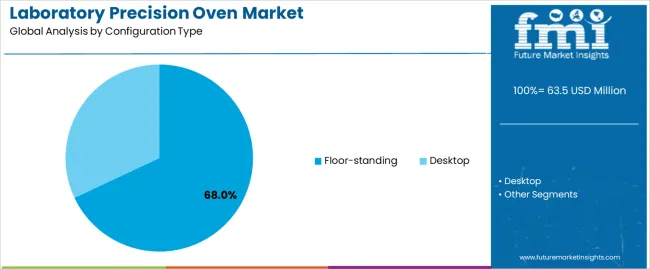
Floor-standing systems command the leading position in the market with approximately 68.0% market share through advanced heating properties, including superior chamber capacity, enhanced temperature uniformity, and operational flexibility that enable laboratories to achieve optimal thermal processing across diverse medical and research environments. The segment benefits from laboratory preference for high-capacity heating systems that provide consistent temperature performance, multi-shelf configurations, and extended operational capability without requiring frequent batch changes or space compromises.
Advanced design features enable large sample volumes, precise temperature control, and integration with existing laboratory workflows, where heating capacity and temperature stability represent critical operational requirements. Floor-standing systems differentiate through proven thermal distribution characteristics, robust construction quality, and compatibility with automated laboratory environments that enhance processing effectiveness while maintaining optimal reliability suitable for diverse high-volume applications.
Key market characteristics include advanced chamber designs with optimized air circulation and insulation capabilities, extended operational effectiveness enabling 98-99% temperature uniformity with consistent heating quality, and laboratory compatibility including programmable controllers, data logging systems, and safety interlocks for scientific processing operations.
Desktop systems maintain space-efficient positioning in the Laboratory Precision Oven market due to their benchtop properties and installation flexibility advantages. These systems appeal to laboratories requiring compact heating equipment with adequate performance for small-batch processing applications. Market adoption is driven by point-of-use testing expansion, focusing convenient access and footprint optimization through compact oven designs while maintaining competitive pricing structures.

Medical applications dominate the market with approximately 52.0% market share due to widespread adoption of precision heating equipment and increasing focus on sterilization processes, sample drying, and diagnostic testing applications that minimize contamination risks while maintaining healthcare quality standards. Medical laboratories prioritize heating reliability, temperature accuracy, and integration with existing laboratory infrastructure that enables coordinated thermal processing application across multiple testing procedures.
The segment benefits from substantial healthcare investment and regulatory compliance programs that emphasize the acquisition of precision heating equipment for sterilization and quality control applications. Hospital laboratory expansion programs incorporate precision ovens as standard equipment for medical testing operations, while diagnostic laboratory industry growth increases demand for reliable heating capabilities that comply with healthcare standards and minimize sample degradation.
Market dynamics include strong growth in hospital laboratories and diagnostic centers requiring sterilization capabilities, increasing adoption in pharmaceutical testing and medical device validation applications for quality assurance, and rising integration with automated laboratory systems for workflow optimization and compliance documentation. Varying healthcare regulations and medical testing procedure differences may influence equipment standardization across different laboratory types or operational scenarios.
College and university applications capture approximately 28.0% market share through specialized heating requirements in teaching laboratories, student research projects, and academic facility applications. These institutions demand reliable heating systems capable of supporting educational programs while providing safe operation and multi-user accessibility capabilities.
Scientific research applications account for approximately 17.0% market share, driven by materials science laboratories, quality control testing, and industrial research facilities requiring precision heating capabilities for experimental procedures and product development.
Other applications represent approximately 3.0% market share, including industrial quality control, food testing laboratories, and specialty applications requiring precision oven capabilities for thermal processing and testing compliance.
Growth Accelerators: Research and development expansion drives primary adoption as laboratory precision ovens provide superior temperature control capabilities that enable scientists to meet stringent experimental standards without excessive equipment costs, supporting research operations and quality assurance missions that require precise thermal processing applications. Laboratory automation infrastructure demand accelerates market expansion as research facilities seek effective heating systems that minimize manual intervention while maintaining operational effectiveness during sample preparation and testing scenarios. Scientific sector spending increases worldwide, creating steady demand for precision equipment that complements traditional laboratory processes and provides experimental differentiation in competitive research markets.
Growth Inhibitors: Capital equipment cost challenges vary across laboratory budgets regarding the acquisition of precision temperature control systems and ongoing maintenance expenses, which may limit operational flexibility and market penetration in regions with constrained research funding or cost-sensitive academic operations. Technical performance limitations persist regarding energy consumption considerations and chamber size constraints that may reduce cost-effectiveness in high-volume processing, continuous operation, or large-sample applications, affecting operational economics and facility requirements. Market fragmentation across multiple laboratory standards and application requirements creates compatibility concerns between different equipment suppliers and existing facility infrastructure.
Market Evolution Patterns: Adoption accelerates in medical testing and pharmaceutical research sectors where temperature precision justifies equipment investment, with geographic concentration in developed markets transitioning toward mainstream adoption in emerging economies driven by research infrastructure expansion and quality control awareness. Technology development focuses on enhanced insulation materials, improved control algorithms, and compatibility with laboratory information systems that optimize thermal processing and data management effectiveness. The market could face disruption if alternative heating technologies or continuous-flow processing innovations significantly limit the deployment of batch-based precision ovens in laboratory applications, though current equipment's unique combination of versatility, reliability, and temperature control continues to make it preferred in scientific applications.
The market demonstrates varied regional dynamics with Growth Leaders including China (6.2% CAGR) and India (5.8% CAGR) driving expansion through research facility capacity additions and laboratory infrastructure programs. Steady Performers encompass Germany (5.3% CAGR), Brazil (4.8% CAGR), and United States (4.4% CAGR), benefiting from established scientific industries and advanced laboratory equipment adoption. Mature Markets feature United Kingdom (3.9% CAGR) and Japan (3.5% CAGR), where specialized research applications and precision equipment integration support consistent growth patterns.

| Country | CAGR (2025-2035) |
|---|---|
| China | 6.2% |
| India | 5.8% |
| Germany | 5.3% |
| Brazil | 4.8% |
| United States | 4.4% |
| United Kingdom | 3.9% |
| Japan | 3.5% |
Regional synthesis reveals Asia Pacific markets leading adoption through research infrastructure expansion and pharmaceutical manufacturing development, while European countries maintain steady expansion supported by scientific excellence advancement and laboratory standardization requirements. North American markets show moderate growth driven by medical testing applications and equipment modernization trends.
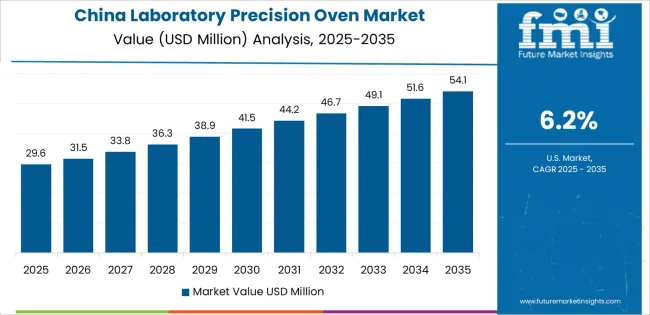
The Chinese market emphasizes advanced equipment features, including precision temperature control and integration with comprehensive laboratory management platforms that manage heating protocols, quality documentation, and testing applications through unified scientific systems. The country demonstrates strong growth at 6.2% CAGR, driven by pharmaceutical research expansion, university laboratory initiatives, and emerging biotechnology development that support precision oven integration. Chinese laboratory managers prioritize operational effectiveness with precision ovens delivering consistent thermal processing through advanced control capabilities and facility adaptation features.
Technology deployment channels include major research institutes, specialized laboratory equipment distributors, and government procurement programs that support scientific applications for complex materials testing and sample preparation applications. Laboratory platform integration capabilities with established scientific systems expand market appeal across diverse operational requirements seeking accuracy and reliability benefits. The expanding research and development sector and accelerating laboratory modernization create steady demand, while innovative applications in nanotechnology research and advanced materials open new growth avenues.
Performance Metrics:
Germany's advanced research market demonstrates sophisticated precision oven deployment with documented operational effectiveness in pharmaceutical development applications and materials science facilities through integration with existing laboratory equipment systems and quality control infrastructure. The country leverages engineering expertise in thermal processing and scientific equipment systems integration to maintain strong growth at 5.3% CAGR. Research centers, including Munich, Berlin, and Frankfurt, showcase premium installations where precision oven systems integrate with comprehensive laboratory platforms and quality management systems to optimize research reliability and processing effectiveness.
German laboratory managers prioritize equipment reliability and regulatory compliance in oven development, creating demand for certified heating systems with advanced features, including validation documentation and traceability integration. The market benefits from established research infrastructure and willingness to invest in precision equipment technologies that provide long-term experimental benefits and compliance with international quality and safety standards.
Market Intelligence Brief:
The USA precision oven market demonstrates sophisticated deployment across biotechnology research applications with documented effectiveness in medical testing and materials development through integration with comprehensive laboratory management systems and quality assurance infrastructure. The country leverages advanced research capabilities in scientific innovation and equipment development technologies to maintain moderate growth at 4.4% CAGR. Research centers, including major academic institutions, pharmaceutical companies, and government laboratories, showcase premium installations where precision oven systems integrate with comprehensive laboratory information platforms and equipment monitoring networks to optimize experimental reliability and data management effectiveness.
American laboratory managers prioritize temperature precision and data integration in equipment development, creating demand for innovative heating systems with advanced features, including connectivity integration and automated documentation systems. The market benefits from established research infrastructure and willingness to invest in advanced laboratory technologies that provide long-term productivity benefits and compliance with FDA and quality standards.
Market Intelligence Brief:
The UK precision oven market demonstrates advanced regulatory deployment with documented operational effectiveness in university research applications and pharmaceutical testing through integration with existing quality systems and laboratory infrastructure. The country leverages scientific expertise in equipment standards and laboratory systems integration to maintain steady growth at 3.9% CAGR. Research centers, including Oxford, Cambridge, and London, showcase premium installations where precision oven systems integrate with comprehensive laboratory management platforms and regulatory compliance systems to optimize research quality and processing effectiveness.
British laboratory managers prioritize regulatory compliance and equipment validation in oven development, creating demand for certified heating systems with advanced features, including calibration documentation and quality tracking integration. The market benefits from established scientific infrastructure and commitment to invest in validated equipment technologies that provide long-term research benefits and compliance with UK and EU laboratory standards.
Strategic Market Indicators:
India's precision oven market demonstrates rapid expansion deployment with documented operational effectiveness in pharmaceutical research applications and university laboratory development through integration with emerging research systems and scientific infrastructure development. The country leverages growing scientific capabilities in research equipment and laboratory systems integration to achieve high growth at 5.8% CAGR. Research centers, including Bangalore, Hyderabad, and Mumbai, showcase expanding installations where precision oven systems integrate with comprehensive laboratory platforms and quality networks to optimize market penetration and research effectiveness.
Indian laboratory managers prioritize cost-effectiveness and local manufacturing in equipment development, creating demand for affordable precision systems with advanced features, including reliable temperature control and minimal maintenance requirements. The market benefits from expanding pharmaceutical research infrastructure and willingness to invest in quality equipment technologies that provide research capability and compliance with international scientific standards.
Market Intelligence Brief:
Brazil's precision oven market shows strong expansion with documented operational effectiveness in university research operations and agricultural testing through integration with developing scientific systems and research infrastructure. The country leverages agricultural research leadership and scientific modernization to achieve growth at 4.8% CAGR. Research centers, including São Paulo, Rio de Janeiro, and Campinas, showcase growing installations where precision oven systems integrate with university laboratories and testing facilities to optimize operational reliability.
Brazilian laboratory managers prioritize equipment durability and tropical climate compatibility, creating demand for robust systems with features including environmental resistance and extended service intervals. The market benefits from expanding research sector and commitment to invest in scientific equipment technologies supporting agricultural innovation and academic research programs.
Market Intelligence Brief:
Japan's precision oven market demonstrates engineering deployment with documented operational effectiveness in pharmaceutical research applications and materials science facilities through integration with advanced quality control systems and manufacturing infrastructure. The country leverages engineering excellence in precision equipment and scientific systems integration to maintain steady growth at 3.5% CAGR. Research centers, including Tokyo, Osaka, and Kyoto, showcase premium installations where precision oven systems integrate with comprehensive quality platforms and automation systems to optimize research excellence and processing effectiveness.
Japanese laboratory managers prioritize equipment precision and quality standards in oven development, creating demand for ultra-precise heating systems with advanced features, including micro-temperature control and comprehensive validation documentation systems. The market benefits from established advanced research infrastructure and commitment to invest in highest-quality equipment technologies that provide superior research positioning and compliance with stringent Japanese quality standards.
Strategic Market Indicators:
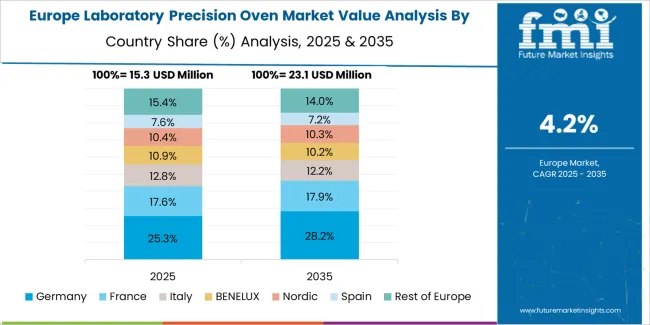
The Laboratory Precision Oven market in Europe is projected to grow from USD 19.8 million in 2025 to USD 30.6 million by 2035, registering a CAGR of 4.5% over the forecast period. Germany is expected to maintain its leadership position with a 27.3% market share in 2025, increasing to 28.1% by 2035, supported by its advanced research infrastructure and major scientific centers in Munich and Berlin.
France follows with a 18.6% share in 2025, projected to reach 19.2% by 2035, driven by comprehensive pharmaceutical research programs and university laboratory modernization. The United Kingdom holds a 16.4% share in 2025, expected to maintain 16.1% by 2035 through specialized academic research activities and regulatory compliance applications. Italy commands a 13.8% share, while Spain accounts for 11.2% in 2025. The Netherlands maintains 6.9% market presence. The Rest of Europe region is anticipated to show steady adoption, expanding its collective share from 5.8% to 6.3% by 2035, reflecting consistent growth in Nordic countries, research expansion in Central European markets, and laboratory modernization across Eastern European scientific facilities.

In Japan, the Laboratory Precision Oven market prioritizes floor-standing systems, which capture the dominant share of university research and pharmaceutical laboratory installations due to their advanced features, including large chamber capacity optimization and seamless integration with existing laboratory workflow infrastructure. Japanese laboratory managers emphasize reliability, precision, and long-term operational excellence, creating demand for floor-standing systems that provide consistent heating capabilities and superior temperature performance based on research requirements and quality standards. Desktop configurations maintain secondary positions primarily in teaching laboratory applications and point-of-use testing installations where compact heating functionality meets operational requirements without compromising space efficiency.
Market Characteristics:
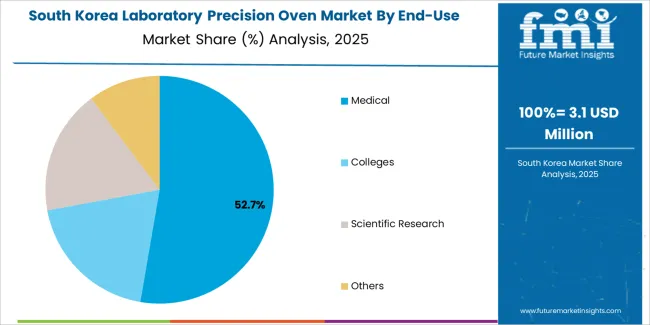
In South Korea, the market structure favors international equipment manufacturers, including Thermo Fisher Scientific, Despatch, and Memmert, which maintain dominant positions through comprehensive product portfolios and established laboratory networks supporting both research institute and industrial testing installations. These providers offer integrated solutions combining advanced precision oven systems with professional technical services and ongoing calibration support that appeal to Korean laboratories seeking reliable heating systems.
Local equipment distributors and technical service providers capture moderate market share by providing localized service capabilities and competitive pricing for standard laboratory oven installations, while domestic manufacturers focus on specialized applications and cost-effective solutions tailored to Korean research market characteristics.
Channel Insights:
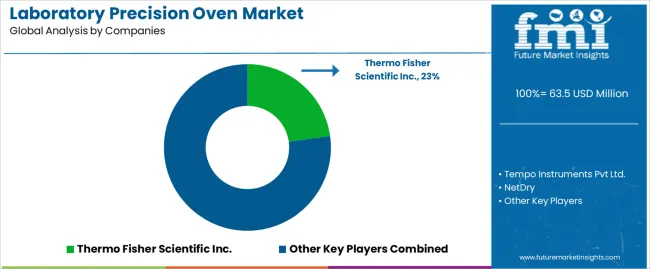
The market operates with moderate concentration, featuring approximately 14-18 meaningful participants, where leading companies control roughly 45-50% of the global market share through established laboratory relationships and comprehensive equipment portfolios. Competition emphasizes temperature control capabilities, chamber design innovation, and technical support integration rather than price-based rivalry alone. The leading company, Thermo Fisher Scientific Inc., commands approximately 22.8% market share through its extensive precision heating product line and global scientific equipment presence.
Market Leaders encompass Thermo Fisher Scientific Inc., Tempo Instruments Pvt Ltd., and NetDry, which maintain competitive advantages through extensive thermal engineering expertise, global laboratory networks, and comprehensive technical support capabilities that create customer loyalty and support premium pricing. These companies leverage decades of laboratory equipment experience and ongoing innovation investments to develop advanced precision oven systems with superior temperature uniformity and control features.
Technology Innovators include Thong & Ong Engineering Sdn Bhd, Despatch, and Carbolite Gero Ltd., which compete through specialized thermal control technology focus and innovative chamber design capabilities that appeal to research facilities seeking advanced heating solutions and performance differentiation. These companies differentiate through rapid product development cycles and specialized scientific application focus.
Regional Specialists feature equipment manufacturers focusing on specific geographic markets and specialized applications, including custom chamber designs and integrated laboratory automation solutions. Market dynamics favor participants that combine reliable heating performance with advanced control capabilities, including programmable temperature profiles and comprehensive data logging features. Competitive pressure intensifies as traditional industrial oven manufacturers expand into laboratory precision systems, while specialized scientific equipment companies challenge established players through innovative connectivity solutions and smart monitoring platforms targeting research institutes and pharmaceutical laboratory segments.
| Item | Value |
|---|---|
| Quantitative Units | USD 63.5 million |
| Configuration Type | Desktop, Floor-standing |
| End-Use Application | Medical, Colleges, Scientific Research, Others |
| Regions Covered | Asia Pacific, Europe, North America, Latin America, Middle East & Africa |
| Countries Covered | China, India, Germany, Brazil, United States, United Kingdom, Japan, and 20+ additional countries |
| Key Companies Profiled | Thermo Fisher Scientific Inc., Tempo Instruments Pvt Ltd., NetDry, Thong & Ong Engineering Sdn Bhd, Despatch, Carbolite Gero Ltd. |
| Additional Attributes | Dollar sales by configuration type and end-use application categories, regional adoption trends across Asia Pacific, Europe, and North America, competitive landscape with equipment manufacturers and laboratory suppliers, customer preferences for temperature precision and chamber capacity, integration with laboratory management platforms and quality monitoring systems, innovations in thermal control formulations and energy efficiency excellence, and development of automated heating solutions with enhanced uniformity and operational optimization capabilities. |
The global laboratory precision oven market is estimated to be valued at USD 63.5 million in 2025.
The market size for the laboratory precision oven market is projected to reach USD 99.6 million by 2035.
The laboratory precision oven market is expected to grow at a 4.6% CAGR between 2025 and 2035.
The key product types in laboratory precision oven market are floor-standing and desktop.
In terms of end-use application, medical segment to command 52.0% share in the laboratory precision oven market in 2025.






Full Research Suite comprises of:
Market outlook & trends analysis
Interviews & case studies
Strategic recommendations
Vendor profiles & capabilities analysis
5-year forecasts
8 regions and 60+ country-level data splits
Market segment data splits
12 months of continuous data updates
DELIVERED AS:
PDF EXCEL ONLINE
Laboratory Information System Market Forecast and Outlook 2025 to 2035
Laboratory Centrifuge & Accessories Market Size and Share Forecast Outlook 2025 to 2035
Laboratory Shakers Market Size and Share Forecast Outlook 2025 to 2035
Laboratory Washers Market Size and Share Forecast Outlook 2025 to 2035
Laboratory Rockers and Shakers Market Size and Share Forecast Outlook 2025 to 2035
Laboratory Filtration Devices Market Size and Share Forecast Outlook 2025 to 2035
Laboratory and Medical Scale Ozone Generator Market Size and Share Forecast Outlook 2025 to 2035
Laboratory Furnaces Market Analysis - Size, Share, and Forecast 2025 to 2035
Laboratory Supplies Market Size and Share Forecast Outlook 2025 to 2035
Laboratory Benchtop Automation Market Growth – Trends & Forecast 2025 to 2035
Laboratory Balances and Scales Market Growth - Industry Forecast 2025 to 2035
Global Laboratory Filter Paper Market Growth – Trends & Forecast 2024-2034
Laboratory Sample Container Market
Laboratory Filtration Equipment Market Growth – Trends & Forecast 2019-2027
Laboratory Glassware and Plasticware Market
Laboratory Ovens Market Analysis by Mechanical Convection and Vacuum Ovens Type through 2035
AI in Laboratory Solution Market Size and Share Forecast Outlook 2025 to 2035
Dental Laboratory Market Size and Share Forecast Outlook 2025 to 2035
Laboratory Grinders Market Size and Share Forecast Outlook 2025 to 2035
Service Laboratory Market Analysis by Service Type, Deployment, Channel, End-user, and Region Through 2035

Thank you!
You will receive an email from our Business Development Manager. Please be sure to check your SPAM/JUNK folder too.
Chat With
MaRIA